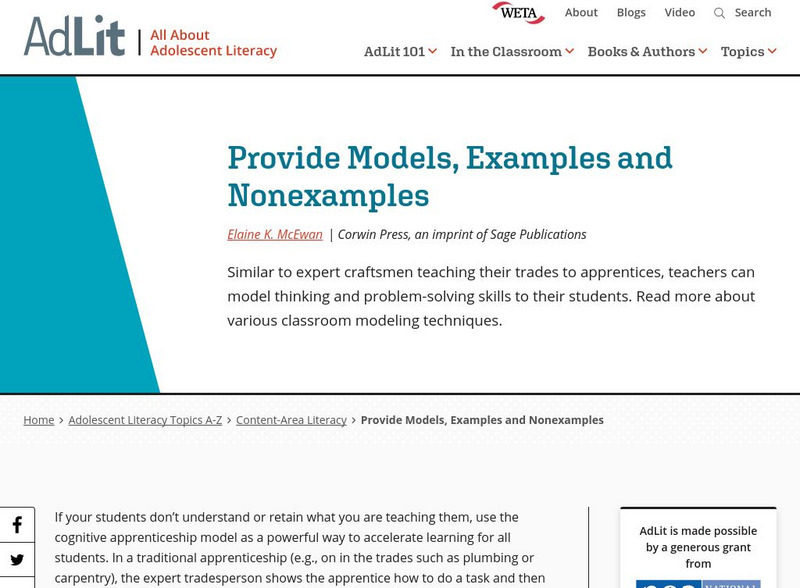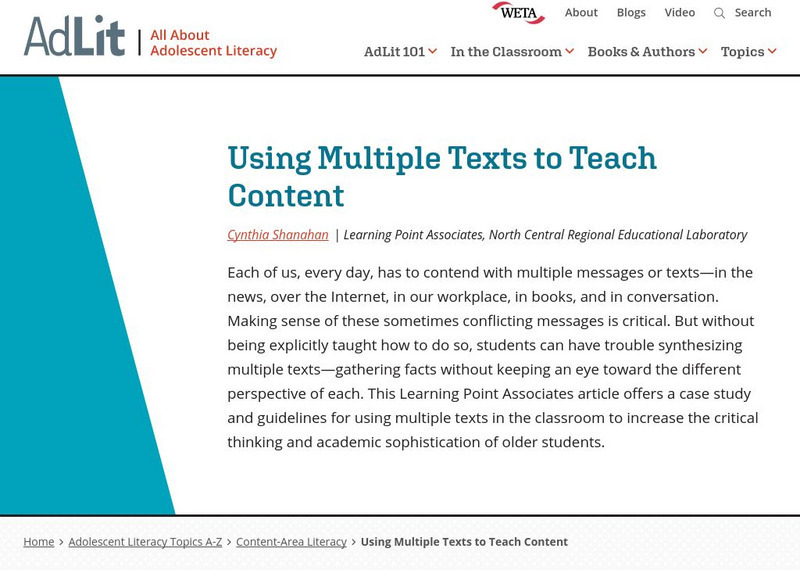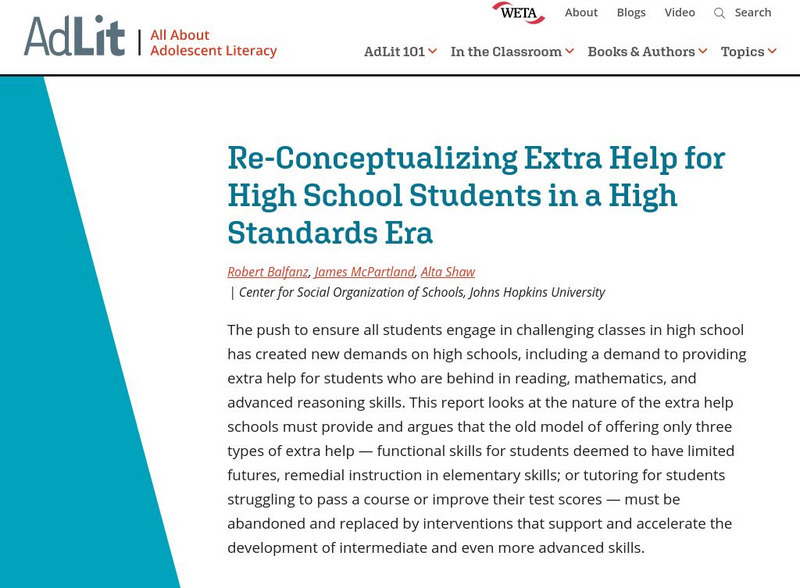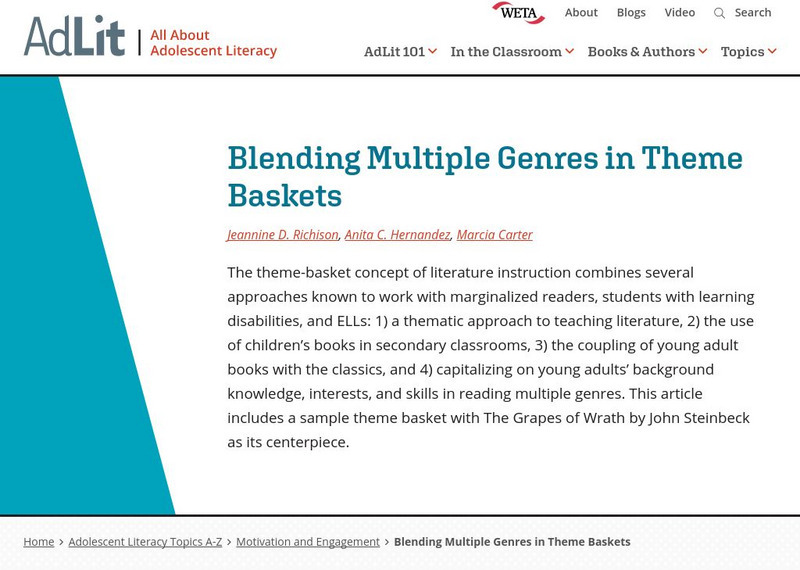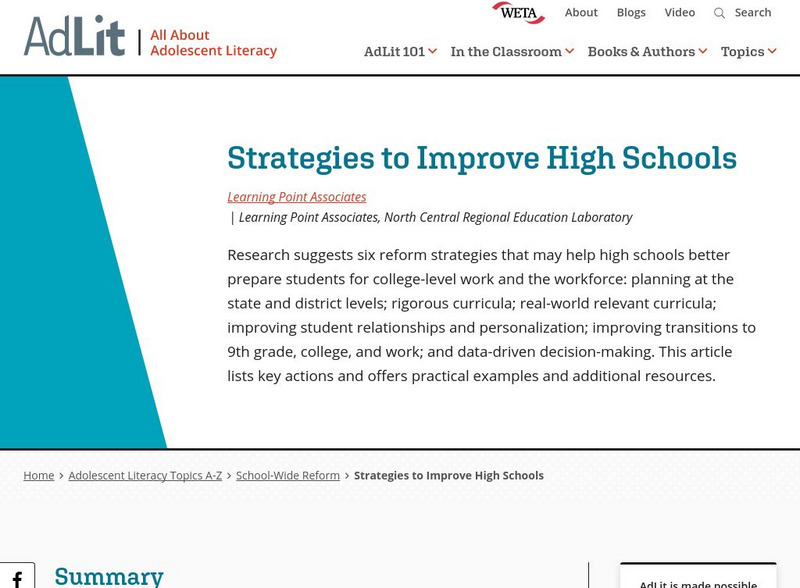AdLit
Ad lit.org: Explicit Comprehension Strategy Instruction
Use explicit strategy instruction to make visible the invisible comprehension strategies that good readers use to understand text. Support students until they can use the strategies independently. Recycle and re-teach strategies...
AdLit
Ad lit.org: Extended Discussion of Text Meaning and Interpretation
Teachers should provide opportunities for students to engage in high-quality discussions of the meaning and interpretation of texts in various content areas as one important way to improve their reading comprehension.
AdLit
Ad lit.org: Recommendations for Improving Adolescent Literacy
In its practice guide Improving Adolescent Literacy: Effective Classroom and Intervention Practices, the Dept. of Education offers five recommendations for increasing the reading ability of adolescents. Those recommendations are...
AdLit
Ad lit.org: The Enhanced Reading Opportunities Study
While much has been learned about literacy in the elementary grades, less is known about programmatic approaches that help struggling adolescent readers acquire the skills they need to succeed in high school. The Enhanced Reading...
AdLit
Ad lit.org: Provide Models, Examples and Nonexamples
Similar to expert craftsmen teaching their trades to apprentices, teachers can model thinking and problem-solving skills to their students. Read more about various classroom modeling techniques.
AdLit
Ad lit.org: Five Areas of Instructional Improvement to Increase Academic Literacy
How can content-area, non-reading-specialist teachers contribute to academic literacy? They can incorporate these five techniques throughout their lessons: (1) provide explicit instruction and supported practice in effective...
AdLit
Ad lit.org: Use Easy Nonfiction to Build Background Knowledge
A Texas librarian shares his strategy of using nonfiction picture books to introduce new concepts to struggling adolescent readers and to build their background knowledge. Once students have been exposed to academic content in easy...
AdLit
Ad lit.org: Teach the Seven Strategies of Highly Effective Readers
To improve students' reading comprehension, teachers should introduce the seven cognitive strategies of effective readers: activating, inferring, monitoring-clarifying, questioning, searching-selecting, summarizing, and...
AdLit
Ad lit.org: Use the Cooperative Learning Model
Cooperative learning fosters group accountability and provides struggling readers with the opportunity to work with stronger academic role models. Learn how to introduce this strategy in the classroom.
AdLit
Ad lit.org: Reading Next
Millions of today's adolescents lack the reading skills demanded by today's world. The impending crisis - millions of under-literate young people unable to succeed economically and socially - requires an immediate response. This report...
AdLit
Ad lit.org: Academic Language: Everyone's "Second" Language
Being able to speak English fluently does not guarantee that a student will be able to use language effectively in academic settings. Fluency must be combined with higher order thinking skills to create an "academic language," which...
AdLit
Ad lit.org: Audiobooks: Ideas for Teachers
Encourage students to become better listeners and readers through audiobooks.
AdLit
Ad lit.org: What Are the Key Elements of Student Engagement?
As part of their series to help schools understand the federal No Child Left Behind Law, Learning Point Associates describes the four key elements of student engagement - student confidence, teacher involvement, relevant texts, and...
AdLit
Ad lit.org: Using Student Engagement to Improve Adolescent Literacy
For struggling adolescent readers, creating student interest is as vital as teaching language skills.
AdLit
Ad lit.org: How to Adapt Your Teaching Strategies to Student Needs
Teachers are often asked to modify instruction to accommodate special needs students. In fact, all students will benefit from the following good teaching practices. The following article takes the mystery out of adapting materials and...
AdLit
Ad lit.org: How to Modify Teaching for Students With Low Organizational Skills
Classrooms today have students with many special needs, and teachers are often directed to "modify as necessary." The following article takes the mystery out of modifying your teaching strategies with concrete examples that focus on...
AdLit
Ad lit.org: Seven Strategies to Teach Students Text Comprehension
Comprehension strategies are conscious plans - sets of steps that good readers use to make sense of text. Comprehension strategy instruction helps students become purposeful, active readers who are in control of their own reading...
AdLit
Ad lit.org: Using Multiple Texts to Teach Content
Each of us, every day, has to contend with multiple messages or texts-in the news, over the Internet, in our workplace, in books, and in conversation. Making sense of these sometimes conflicting messages is critical. But without being...
AdLit
Ad lit.org: Re Conceptualizing Extra Help for High School Students
The push to ensure all students engage in challenging classes in high school has created new demands on high schools, including a demand to providing extra help for students who are behind in reading, mathematics, and advanced reasoning...
AdLit
Ad lit.org: Blending Multiple Genres in Theme Baskets
The theme-basket concept of literature instruction combines several approaches known to work with marginalized readers, students with learning disabilities, and ELLs: 1) a thematic approach to teaching literature, 2) the use of...
AdLit
Ad lit.org: Grouping Students Who Struggle With Reading
There are a variety of grouping formats that have been proven effective for teaching reading to students with learning disabilities: whole class, small group, pairs, and one-on-one. This article summarizes the research and implications...
AdLit
Ad lit.org: Summer Bridge Programs
More students fail ninth grade than any other grade and many of these students ultimately drop out. Can pre-emptive interventions lead to increased graduation rates? Emerging evidence suggests that eight-grade transition programs...
AdLit
Ad lit.org: Strategies to Improve High Schools
Research suggests six reform strategies that may help high schools better prepare students for college-level work and the workforce: planning at the state and district levels; rigorous curricula; real-world relevant curricula; improving...
AdLit
Ad lit.org: A Closer Look: Closing the Performance Gap
The performance gap - what students are expected to do versus what they can do - is compounded each year a child falls short of acquiring expected skills. As a result, underachieving high school students are at great risk for academic...






